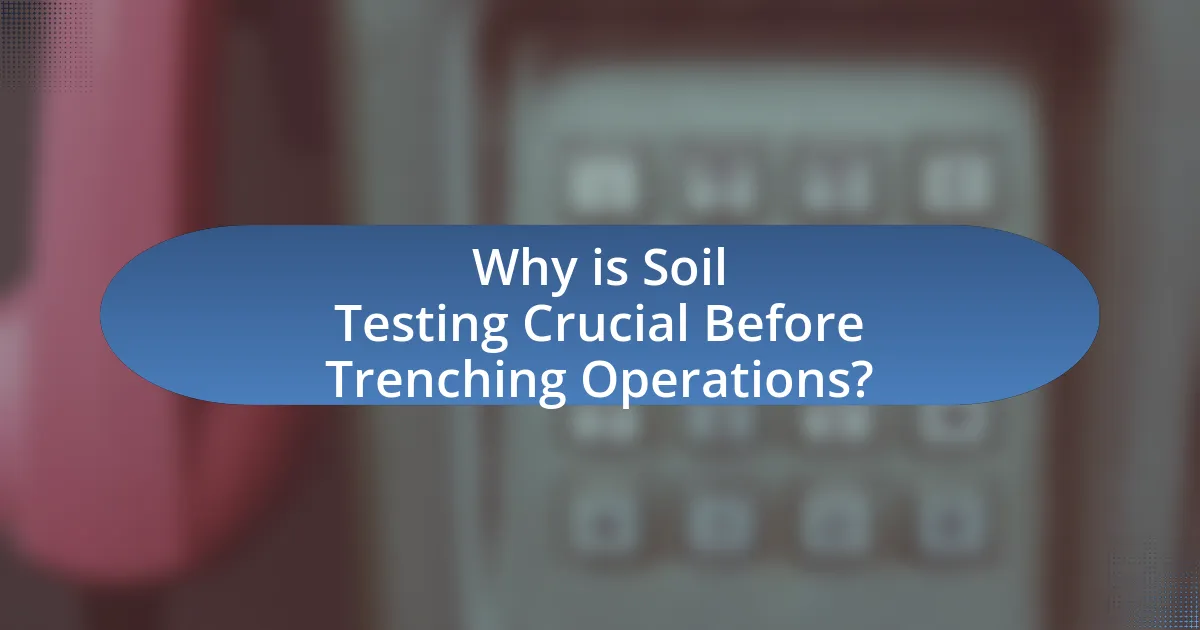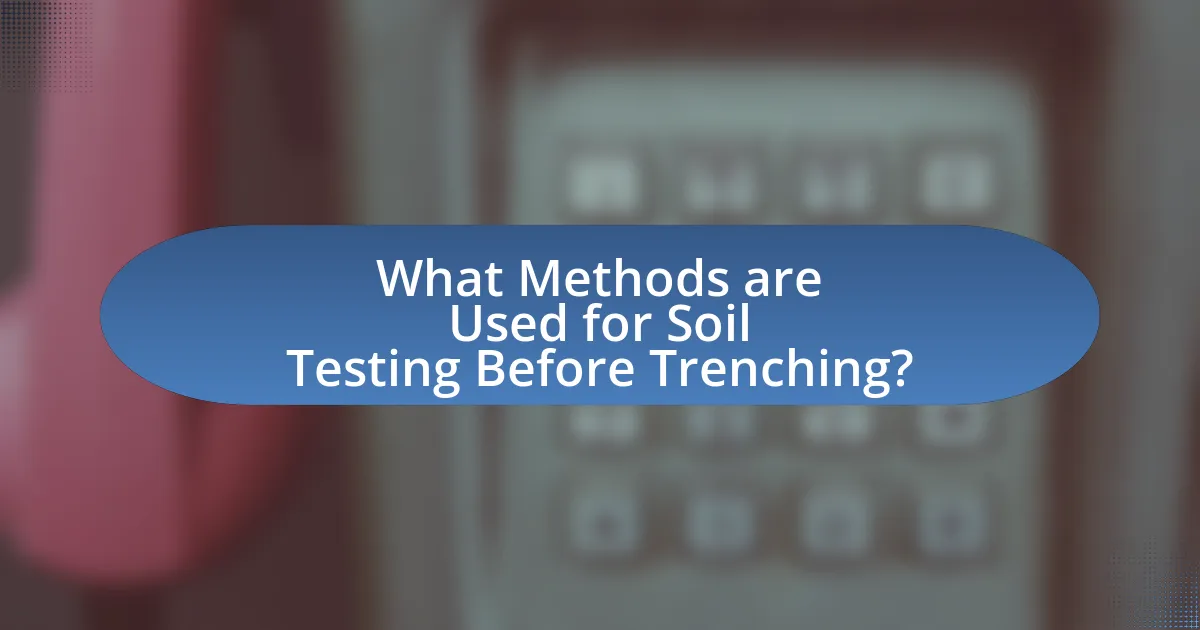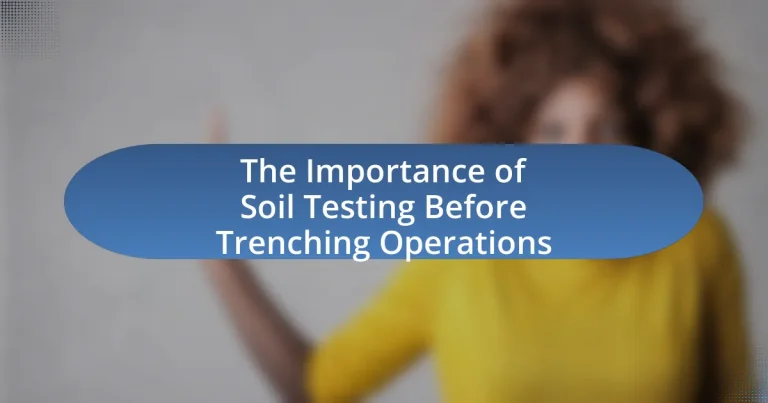Soil testing is a critical process before trenching operations, as it assesses soil stability, composition, and moisture levels, which are essential for ensuring safety and project feasibility. The article outlines the importance of soil testing in preventing structural failures, cave-ins, and contamination exposure, emphasizing compliance with safety regulations set by organizations like OSHA. It details various soil testing methods, best practices for accurate sampling, and the implications of soil characteristics on trenching safety. Additionally, the article addresses common misconceptions and mistakes in soil testing, highlighting the necessity of thorough analysis to mitigate risks during excavation activities.

Why is Soil Testing Crucial Before Trenching Operations?
Soil testing is crucial before trenching operations to assess soil stability and composition, which directly impacts safety and project feasibility. Conducting soil tests helps identify potential issues such as soil contamination, moisture levels, and load-bearing capacity. For instance, the American Society of Civil Engineers emphasizes that understanding soil characteristics can prevent structural failures and costly delays during construction. Additionally, soil testing can reveal the presence of underground utilities, reducing the risk of accidents and ensuring compliance with local regulations.
What are the primary reasons for conducting soil tests prior to trenching?
Conducting soil tests prior to trenching is essential for ensuring safety, determining soil stability, and assessing environmental conditions. Soil tests reveal the composition, moisture content, and load-bearing capacity of the soil, which are critical factors in preventing trench collapses and ensuring structural integrity. For instance, the Occupational Safety and Health Administration (OSHA) emphasizes that understanding soil characteristics can significantly reduce the risk of accidents during excavation work. Additionally, soil tests help identify potential contamination, guiding necessary remediation efforts and compliance with environmental regulations.
How does soil composition impact trenching safety?
Soil composition significantly impacts trenching safety by influencing the stability and integrity of trench walls. For instance, cohesive soils, such as clay, tend to hold together better and can support steeper trench walls, while granular soils, like sand, are more prone to collapse and require shallower angles of repose. According to the Occupational Safety and Health Administration (OSHA), trenching in unstable soil types increases the risk of cave-ins, which are a leading cause of fatalities in excavation work. Therefore, understanding the specific soil composition through testing is crucial for implementing appropriate safety measures, such as shoring or sloping, to mitigate these risks effectively.
What role does soil moisture play in trenching operations?
Soil moisture significantly influences trenching operations by affecting soil stability and excavation ease. Adequate moisture levels can enhance soil cohesion, reducing the risk of collapse during trenching. Conversely, excessive moisture can lead to muddy conditions, increasing the difficulty of excavation and the potential for equipment bogging down. Research indicates that optimal soil moisture content is crucial for maintaining trench walls’ integrity, as noted in studies on soil mechanics, which demonstrate that saturated soils can lose strength and lead to hazardous conditions.
How can soil testing prevent potential hazards during trenching?
Soil testing can prevent potential hazards during trenching by identifying soil composition, stability, and moisture content, which are critical for safe excavation. By analyzing these factors, construction teams can assess the risk of soil collapse, identify the presence of contaminants, and determine the appropriate shoring methods needed to ensure worker safety. For instance, the Occupational Safety and Health Administration (OSHA) emphasizes that soil testing is essential for preventing trench-related accidents, which account for a significant number of construction fatalities each year.
What types of hazards can arise from inadequate soil testing?
Inadequate soil testing can lead to several hazards, including structural failures, cave-ins, and contamination exposure. Structural failures occur when the soil cannot support the weight of equipment or structures due to unknown soil conditions. Cave-ins are a significant risk in trenching operations, where unstable soil can collapse, posing serious safety threats to workers. Contamination exposure arises when hazardous materials in the soil are not identified, potentially leading to health risks for workers and environmental damage. According to the Occupational Safety and Health Administration (OSHA), proper soil testing is essential to prevent these hazards and ensure safe excavation practices.
How does soil testing contribute to worker safety?
Soil testing contributes to worker safety by identifying hazardous conditions such as soil contamination, instability, and the presence of toxic substances. By analyzing soil samples, workers can determine the appropriate safety measures needed to mitigate risks associated with trenching operations. For instance, the Occupational Safety and Health Administration (OSHA) emphasizes that understanding soil characteristics helps prevent cave-ins and exposure to harmful chemicals, thereby reducing the likelihood of accidents and health issues among workers.

What Methods are Used for Soil Testing Before Trenching?
Soil testing before trenching typically employs methods such as soil sampling, laboratory analysis, and in-situ testing. Soil sampling involves collecting soil from various depths and locations to assess its composition and properties. Laboratory analysis then evaluates parameters like moisture content, pH, and nutrient levels, which are crucial for understanding soil behavior during trenching. In-situ testing methods, such as Standard Penetration Tests (SPT) and Cone Penetration Tests (CPT), provide real-time data on soil density and strength, ensuring safe trenching operations. These methods are essential for identifying potential issues like soil instability or contamination, thereby minimizing risks during excavation.
What are the common techniques for soil analysis?
Common techniques for soil analysis include soil sampling, pH testing, texture analysis, nutrient analysis, and organic matter assessment. Soil sampling involves collecting soil from various depths and locations to ensure representative results. pH testing measures the acidity or alkalinity of the soil, which affects nutrient availability. Texture analysis determines the proportions of sand, silt, and clay, influencing water retention and drainage. Nutrient analysis evaluates essential elements like nitrogen, phosphorus, and potassium, which are critical for plant growth. Organic matter assessment quantifies decomposed plant and animal material, impacting soil fertility and structure. These techniques are essential for understanding soil health and guiding effective trenching operations.
How does laboratory testing differ from field testing?
Laboratory testing differs from field testing primarily in the controlled environment versus real-world conditions. Laboratory testing occurs in a controlled setting where variables can be managed, allowing for precise measurements and analyses of soil properties, such as moisture content and particle size distribution. In contrast, field testing takes place in the actual environment where the soil will be excavated, providing insights into how soil behaves under natural conditions, including factors like compaction and moisture variability. This distinction is crucial for trenching operations, as laboratory results may not fully represent field conditions, potentially impacting safety and project outcomes.
What equipment is typically used in soil testing?
Soil testing typically utilizes equipment such as soil augers, soil probes, pH meters, and laboratory analysis tools. Soil augers are used to collect soil samples from various depths, while soil probes allow for easier sampling in compacted soils. pH meters measure the acidity or alkalinity of the soil, which is crucial for understanding nutrient availability. Laboratory analysis tools, including spectrophotometers and chromatographs, are employed to analyze the chemical composition of the soil samples. These tools ensure accurate assessment of soil properties, which is essential for informed decision-making in trenching operations.
How do different soil tests provide valuable information?
Different soil tests provide valuable information by analyzing soil properties such as pH, nutrient levels, and texture, which directly influence plant growth and soil management practices. For instance, a pH test reveals the acidity or alkalinity of the soil, affecting nutrient availability; a nutrient test identifies essential elements like nitrogen, phosphorus, and potassium, guiding fertilization strategies; and a texture test determines the proportion of sand, silt, and clay, influencing water retention and drainage. These analyses enable informed decisions for agricultural practices, ensuring optimal crop yields and sustainable land use.
What specific data can be obtained from soil pH tests?
Soil pH tests provide specific data on the acidity or alkalinity of the soil, measured on a scale from 0 to 14. This data is crucial for understanding nutrient availability, as certain nutrients are more accessible to plants at specific pH levels; for example, phosphorus is most available between pH 6 and 7. Additionally, soil pH influences microbial activity and the overall health of the soil ecosystem, which can affect plant growth and soil structure. Accurate pH readings can guide soil amendments, such as lime or sulfur, to optimize conditions for trenching operations and subsequent agricultural practices.
How do compaction tests influence trenching decisions?
Compaction tests significantly influence trenching decisions by providing critical data on soil density and stability. These tests determine whether the soil can support the weight of construction equipment and structures, thereby guiding decisions on trench depth and width. For instance, a compaction test revealing insufficient soil density may lead to the need for additional stabilization measures, such as adding gravel or using geotextiles, to prevent trench collapse. This is supported by industry standards, which indicate that proper compaction levels are essential for ensuring safety and structural integrity during excavation activities.

What Best Practices Should be Followed for Soil Testing?
The best practices for soil testing include collecting samples from multiple locations, ensuring proper depth and timing, and using appropriate testing methods. Collecting samples from various spots within the area provides a representative analysis of the soil’s characteristics, as soil properties can vary significantly even over short distances. Sampling should be conducted at the correct depth, typically 6 to 12 inches for surface soil, to accurately assess the conditions relevant to trenching operations. Additionally, testing should be performed during dry weather to avoid the influence of moisture on the results. Utilizing standardized testing methods, such as those outlined by the American Society for Testing and Materials (ASTM), ensures reliable and consistent results. Following these practices enhances the accuracy of soil assessments, which is crucial for safe and effective trenching operations.
How can one ensure accurate soil test results?
To ensure accurate soil test results, one must collect samples from multiple locations and depths within the area of interest. This practice allows for a comprehensive representation of the soil’s characteristics, as soil properties can vary significantly across short distances. According to the USDA Natural Resources Conservation Service, collecting samples from at least 10 to 15 different spots and mixing them can enhance the reliability of the results. Additionally, using clean tools and containers prevents contamination, which can skew test outcomes. Properly following laboratory protocols for sample submission further ensures that the analysis reflects the true soil conditions.
What steps should be taken to collect soil samples properly?
To collect soil samples properly, follow these steps: first, select the sampling site based on the area of interest, ensuring it represents the soil conditions accurately. Next, use a clean sampling tool, such as a soil auger or spade, to extract soil from the desired depth, typically 6 to 12 inches for most tests. After obtaining the sample, place it in a clean, labeled container to avoid contamination. Finally, ensure the sample is stored in a cool, dry place until it can be sent to a laboratory for analysis. These steps are crucial for obtaining reliable soil test results, which inform trenching operations and ensure safety and compliance with regulations.
How often should soil testing be conducted before trenching?
Soil testing should be conducted at least once a year before trenching. This frequency ensures that any changes in soil composition, nutrient levels, and potential contaminants are identified in a timely manner. Regular testing is crucial because soil conditions can vary significantly over time due to factors such as weather, land use changes, and organic matter decomposition. According to the USDA Natural Resources Conservation Service, annual soil testing helps maintain optimal soil health and informs necessary amendments, which is essential for safe and effective trenching operations.
What are the common mistakes to avoid in soil testing?
Common mistakes to avoid in soil testing include not collecting samples from multiple locations, failing to follow proper sampling techniques, and neglecting to analyze the samples in a timely manner. Collecting samples from only one location can lead to inaccurate representations of soil conditions, as soil properties can vary significantly across a site. Proper sampling techniques, such as using clean tools and avoiding contamination, are crucial for obtaining reliable results. Additionally, timely analysis is essential because soil properties can change over time, affecting the accuracy of the test results. These mistakes can compromise the effectiveness of soil testing, leading to poor decision-making in trenching operations.
How can improper sampling affect trenching outcomes?
Improper sampling can lead to inaccurate assessments of soil conditions, which negatively impacts trenching outcomes. When soil samples are not representative of the entire area, critical factors such as soil composition, moisture content, and contamination levels may be misjudged. This can result in inadequate trench design, increased risk of structural failure, and unexpected costs due to the need for additional excavation or remediation. For instance, a study by the American Society of Civil Engineers highlights that 30% of construction delays are attributed to unforeseen soil conditions, emphasizing the necessity of accurate sampling for effective trenching operations.
What misconceptions exist about soil testing in trenching operations?
Misconceptions about soil testing in trenching operations include the belief that soil testing is unnecessary if the site appears stable and that visual inspection alone suffices for assessing soil conditions. These misconceptions can lead to inadequate preparation and increased risks during excavation. For instance, a study by the American Society of Civil Engineers highlights that undetected soil instability can result in trench collapses, emphasizing the need for thorough soil analysis regardless of surface appearances. Additionally, some assume that soil testing is a one-time process, whereas ongoing testing is crucial as soil conditions can change over time due to environmental factors.
What practical tips can enhance soil testing effectiveness?
To enhance soil testing effectiveness, it is crucial to collect samples from multiple locations within the testing area to ensure representative results. This practice allows for a comprehensive understanding of soil variability, which is essential for accurate analysis. According to the USDA Natural Resources Conservation Service, taking samples from at least 10 different spots and mixing them can provide a more reliable average of soil conditions. Additionally, testing at the appropriate depth, typically 6 to 8 inches for most crops, ensures that the analysis reflects the root zone where nutrient uptake occurs. Properly labeling and documenting each sample location further aids in tracking soil characteristics and changes over time, thereby improving the overall effectiveness of soil testing.


